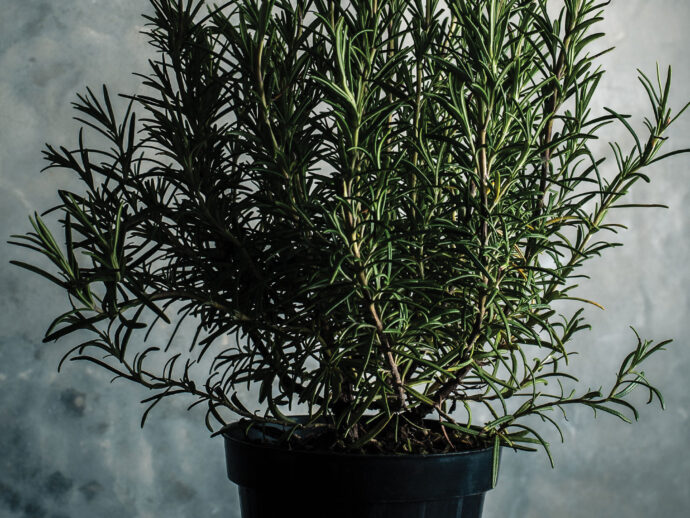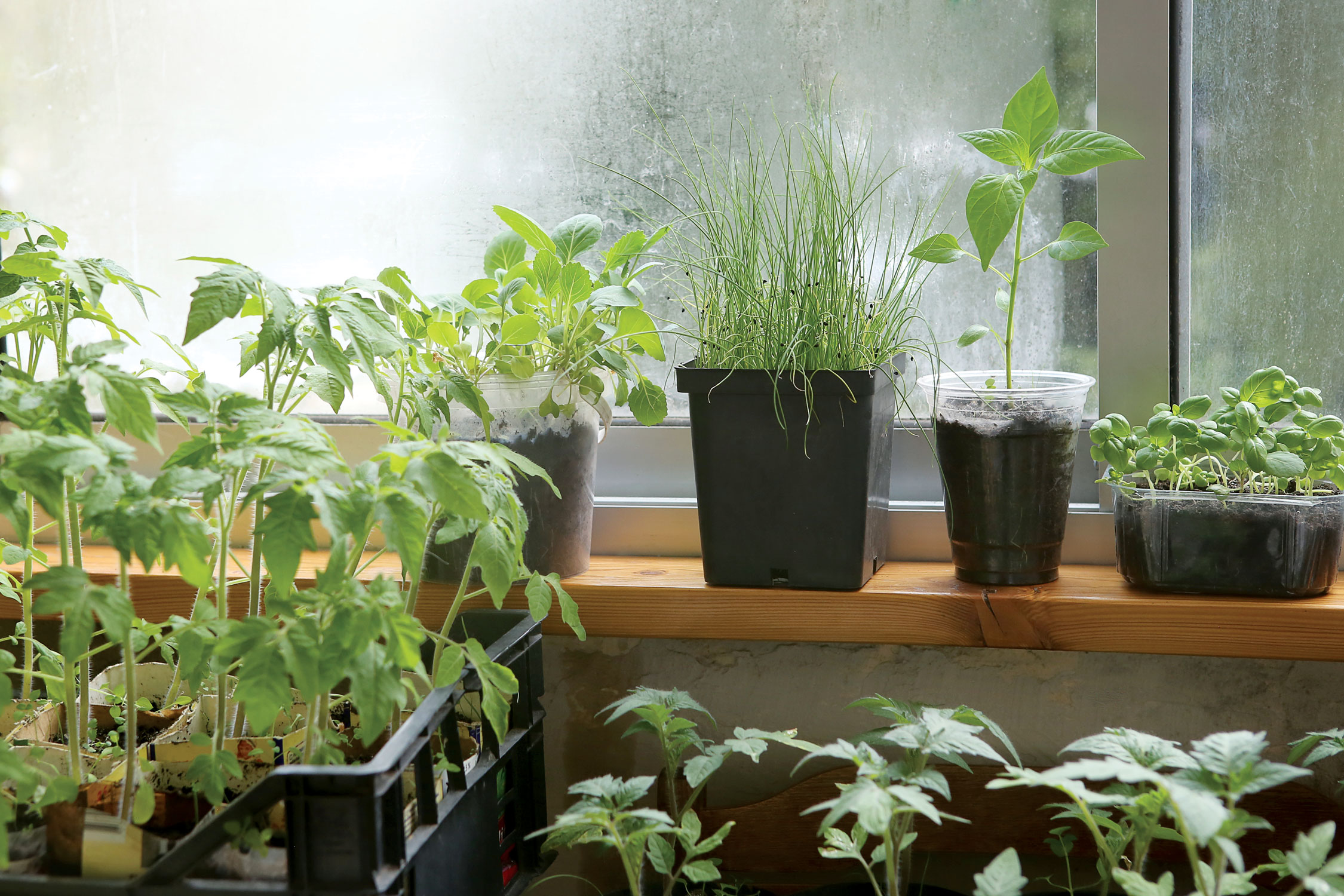
Versatile, potent, sensual, spiritual—herbs are extraordinary plants. Join a rookie herbaphile as she learns from the experts and attempts an indoor garden.
“Romarin. Rosemary.”
With a flourish, the vendor offered me a fresh-cut sprig, and I inhaled.
Maybe I was responding to the French name, which reminded me of Romeo. More likely, it was the smell, an olfactory world away from the dry, twiggy stuff in our spice rack at home. Whatever the reason, this breath of botanical magic left me swooning.
I was 10, visiting Montreal’s Atwater Market for the first time. I gave no thought back then to the work of the farmer who’d carted his fresh herbs to the city for market day. I’m not even sure I thanked him. But the experience stuck. Over the years, in my various city apartments—exclusively indoor abodes—I dreamed of gardens and patios and balconies. Peaceful, open-air spaces I could fill with the scents of my own potted herbs. If only …
Eventually, decades after that first market visit, hankering for a bit of summer, I changed my approach. So hubby and I didn’t have a balcony. So I’d never grown anything from scratch before. So it was December. So what? We had a large west-facing window and some available space on the dining table. I would grow an indoor herb garden … or at least learn a few things trying.
First stop, Westham Island Herb Farm
Step one was a visit to Westham Island Herb Farm in Delta, BC, where I chatted with head farmer Sharon Ellis.
December is, naturally, a slow time of year for this historic family farm, which also harvests strawberries and an abundance of vegetables. Still, I had no trouble picturing the rows of organic seedlings that would be thriving in Ellis’s greenhouse come spring: cilantro, dill, oregano, and, of course, best-selling basil. Lots of it.
Fortunately, cutting huge quantities of basil is one of Ellis’s favourite tasks. “It’s all about the smell,” she said with a knowing smile. There was no basil in the greenhouse just then, but Ellis held out a slender leaf of lemon verbena. I closed my eyes and could have sworn I was smelling my grandmother’s fresh-baked lemon bars.
My rookie enthusiasm intensified (I blame the verbena). Back in the cheerful, rustic market building, I asked if someone in my circumstances could possibly experience the thrill of nurturing her own herbs from “farm” to table.
Luckily for me, Ellis is passionate about education. She encourages visitors of all ages to stroll her fields and discover truths the modern grocery store conceals: our profound connection to nature, the vital importance of farming, and the seasonality of our food, to name a few. And, yes, she patiently helps clueless beginners grow their own herbs.
I left Westham Island Herb Farm with a wealth of helpful tips (and a beautiful head of cauliflower, picked that morning). I decided to plant two different beginner-friendly herbs. Ellis suggested I go with leafy, fast-growing annuals. Basil was a shoo-in, but I wasn’t sure what else to try.
Insight from Blue Lagoon Organics
Inspiration came later that day from Lori Ann Regnier of Blue Lagoon Organics, a herb and produce farm in St. François Xavier, Manitoba. In her reply to a query I’d sent, Regnier sang the praises of an underappreciated herb: “Restaurants use parsley as a garnish on your plate, whereas it should be considered an important part of the meal. Parsley is antibacterial, antioxidant, and anti-inflammatory. It is such an important source of vitamin C, vitamin A, and beta carotene that half your salad should be parsley.”
Well, I was convinced. Parsley it would be!
At the gardening shop, I found organic seeds, soil, inexpensive trays, and a few full-spectrum light bulbs to trick the plants into thinking it was July. A couple of spills and restarts later (I should’ve known potting soil would catch Fido’s attention!) my herbs were planted. All that remained to do was water and wait.
Keep Fido flea-free-herbally!
Many natural treatments repel fleas and ticks. For an easy, effective flea spray, cover 1 sliced lemon, 2 sprigs of fresh rosemary, and 1 sprig of garden sage with 4 cups (1 L) of almost-boiling water. Let steep for 8 hours, then strain into a spray bottle. Store in the fridge. Spritz your pup daily, focusing on her belly, tail, legs, and ears.
Sage advice from Lowland Herb Farm
Waiting, however, is not one of my strengths. Eager to fill my kitchen with herbal aromas, I visited the winter farm market, where I met Boni Townshend of Lowland Herb Farm. Townshend, a market stalwart, has been growing herbs organically on her Chilliwack, BC, farm for more than 45 years. I was delighted by her story of discovering her passion in deepest December: “First Christmas at my farm, I scratched under the snow for sage for turkey stuffing, and I couldn’t believe the flavour difference. I was amazed and hooked on herbs.”
A few leaves of frosty sage led to the careful and sustainable cultivating of a tempting variety of culinary herbs. From the hand-labelled bunches at Townshend’s stand, I selected lemon thyme, Vietnamese cilantro, Italian oregano, and purple sage. Townshend threw in a stalk of bay leaves, recommending that I try bay leaf tea for its many health benefits.
Enjoy a BLT (Bay Leaf Tea)
Like parsley, bay leaves are packed with nutrients and underappreciated. Research connects them to improved blood sugar and lipid levels, among other benefits. Prepare your therapeutic BLT by adding 4 to 5 dried bay leaves and 1 cinnamon stick to 4 cups (1 L) of water and simmering for 20 minutes.

Beginner tips for windowsill herbs
You don’t need to be a great gardener, or even have a garden, to enjoy success with herbs. Here are a few general tips to get your indoor herb garden started.
- Choose fast-growing, leafy herbs such as basil, cilantro, chives, dill, mint, or parsley.
- Use simple containers—anything from paper cups to plastic trays will work.
- Use a fine-grain soil. Special seeding soils are widely available.
- Check the packet information to find out if you need to soak seeds before planting.
- Sow seeds to a depth one to three times the diameter of the seed; follow the packet guidelines for spacing.
- Put containers in a warm place and cover them with newspaper until seeds sprout.
- After sprouting, be sure to expose herbs to at least five hours of sunlight per day (basil likes quite a bit more). If necessary, supplement with full-spectrum light bulbs.
- Maintain a medium-low level of moisture.
- Add a little fish fertilizer once a week to give the plants an organic boost.
- Wait one to four weeks, depending on the plant and season, then start enjoying your herbs!
For more information about growing your own herb garden, indoors or outside, West Coast Seeds’ website (westcoastseeds.com) offers detailed how-to-grow guides for specific herbs.
Not just for cooking
Herbs are marvellous multitaskers! In fact, versatility is a defining feature of the plants we call herbs. For every way herbs help us out, volumes have been written. Below are some recent herbals worth reading.
Culinary
We’re all familiar with parsley, sage, rosemary, and thyme. But how about sweet cicely, chocolate mint (yes, it’s a thing!), or lemon savory? “Nature has so many treasures to offer us that we could try a different herb every day,” writes German herb farmer Maiga Werner. Her Cooking with Fresh Herbs (Ullmann, 2016) is a beautiful season-by-season collection of recipes to help you incorporate old standbys and novelties alike into your cooking.
For those interested in the many benefits of herbal teas, the recipes in Grainger and Sullivan’s Infuse (Hamlyn, 2016) are gorgeously presented and helpfully organized.
Medicinal
“It never ceases to amaze me the depth of healing that can come from working with herbs,” says Michael Vertolli, a former member of Health Canada’s Advisory Panel on Natural Health Products. The New Healing Herbs (Rodale, 2017) by Michael Castleman is a research-based compendium of clear and specific information on more than 130 potent medicinal herbs.
Household
From cleaning surfaces to moisturizing skin, herbs will help do the job—effectively, fragrantly, and safely. The Herbal Handbook for Home and Health (North Atlantic, 2015) by Welsh herbalist Pip Waller is a vintage-style collection of recipes for such things as “thyme disinfectant scouring powder” and “agrimony teachers’ gargle.”
Aromatic
The 25th anniversary edition of Valerie Ann Worwood’s Complete Book of Essential Oils and Aromatherapy (New World Library, 2016) opens with the compelling idea that plant essences “provide us with a fragrant pharmacy full of remedies and delights for all aspects of our lives.” Find 600-plus pages of aromatherapy guidance in Worwood’s encyclopedic tome.
Sacred
In Oaxaca, Mexico, Salvia divinorum, a relative of common sage, is used during spiritual healing sessions. Anglo-Saxons chanted the “Nine Herb Charm” in praise of their most sacred herbs. For anyone curious about incorporating herbs into seasonal rituals, ceremonies, or meditations, ethnobotanist E. Barrie Kavasch’s The Medicine Wheel Garden (Bantam, 2002) is an inspiring work.
Culinary renaissance with fresh herbs
My cooking success tends to be hit-and-miss, but I credit fresh herbs with upping my hit rate. Motivated by the experts, I’ve gone from shaking random bottles of stale, twiggy stuff over soups and stews to planning dishes around fresh herbal ingredients. On my cooking nights (hubby and I take turns) I let the smells trick me into thinking I’m Julia Child in her Provençal kitchen.
The result? We’ve recently dined on such novelties as roasted parsnips with lemon thyme, rosemary-crusted lamb chops, cauliflower gratin with purple sage, and more—all of it enhanced by a herbal je ne sais quoi.
As for my tabletop herb garden, it’s slow growing, but stocky little basil leaves have appeared and delicate parsley shoots are just now poking through the surface. Although I followed the instructions (more or less), I’m still amazed it worked.
Each new pop of pale green, every sign of planthood, is exhilarating and mesmerizing. This may not be a sunny terrace, but I’ve taken to contemplating the little herbs throughout the day and occasionally catching a whiff of summer in the air.
Botanical magic indeed.
To the Atwater Market herb vendor who introduced me to this world so long ago: merci.
Keeping it fresh
Ever wondered how to prevent that beautiful, fragrant bunch of basil you picked up at the market from turning to slime in your fridge? Follow these tips for keeping cut herbs looking and tasting their best.
- Rosemary, sage, thyme, oregano, and others with coarse stems and leaves are native to warm, dry climates and retain their moisture with little help from us. Loosely wrap them in a damp paper towel, then store in the fridge in an airtight container.
- Leafy, soft-stemmed herbs such as cilantro, parsley, and mint should be rinsed (to remove slime-causing bacteria) and patted dry or spun in a salad spinner. Trim the stems, then place in a jar containing about 1 in (2.5 cm) of water. Cover the jar and store in the fridge.
- Basil is an outlier! Prep it as you would other leafy herbs, but put the jar (uncovered) in a warm, bright place.
Herbaphiles unite!
The Herb Society of Manitoba has been meeting every month for more than 20 years. These herb aficionados maintain a large demonstration garden in Winnipeg’s Assiniboine Park, as well as an informative website.
When asked about favourite herbs, garden co-chair Shelley Walker singles out the household variety, saying they give us “a glimpse of history—before we went to stores for all our dyes, cleaners, and insecticides.”
Meadowsweet, for example, was grown as a “strewing herb,” thrown on floors “to give a sweet smell when walked on.” Visit the society’s website (herbsocietymb.com) or garden for more herbal lore!



































